Atomexpo 2019, part 1: events and spacecraft
On April 15-16, Sochi hosted the eleventh international forum Atomexpo-2019. I was there as part of the bloggers invited by Rosatom. A lot of materials and impressions have accumulated over two days, so I divided them into three parts. There will be a story about the events - the opening of the forum, plenary discussions, awarding of the Atomexpo Awards. In the second post - my impressions of the exposition. And I want to single out a separate third publication to talk about pro-atomic environmental activists.
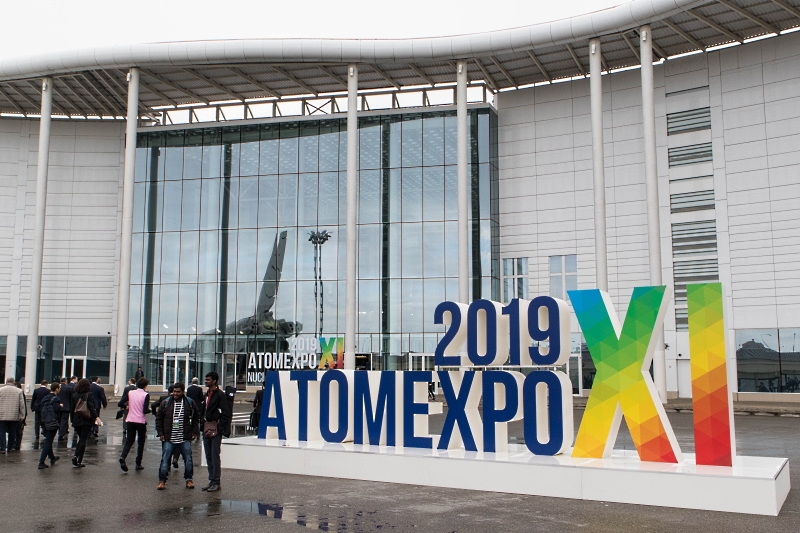
The forum was held in the Main Media Center. Large spaces, which in an empty form resemble a mixture of the airport and the pool, were transformed into something much more green and comfortable, but at the same time filled with high technology. Maybe that is what the future looks like.

Grand opening of the forum. To the left is Alexei Likhachev, Director General of Rosatom State Corporation, Agneta Rising, Director General of the World Nuclear Association, in yellow, the company is made up of senior officials of the IAEA, the European Commission and the OECD Nuclear Energy Agency.
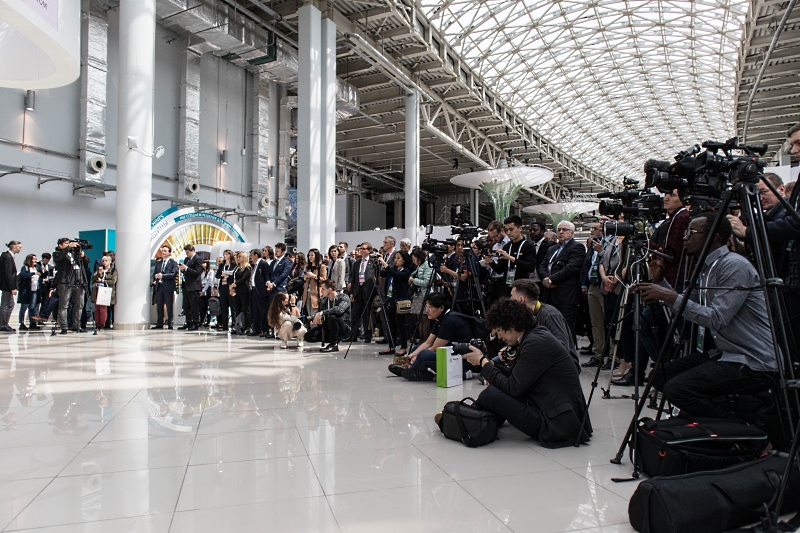
The forum has registered more than 4000 people from 74 countries and more than 290 representatives of Russian and foreign media, the opening recorded dozens of various gadgets from action cameras and smartphones to professional devices.
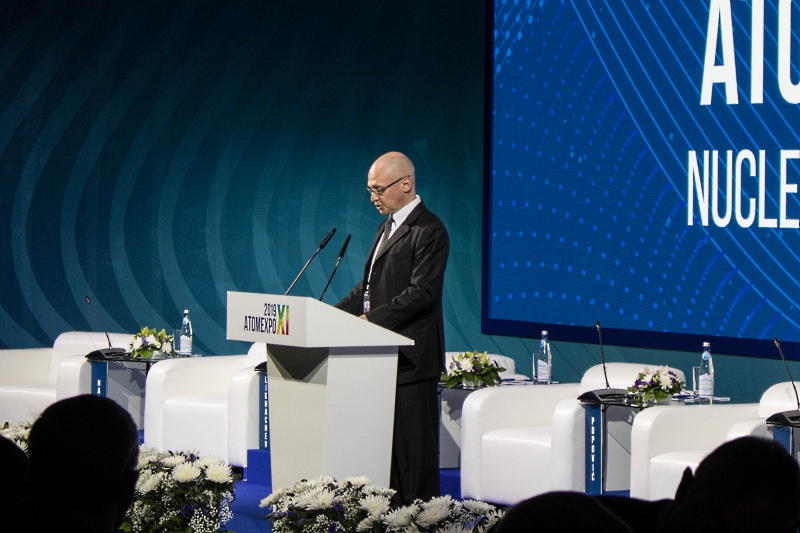
After the grand opening and bypass of the exhibition, a plenary session began. It was opened by Sergei Kiriyenko, who led Rosatom from 2005 to 2016, who read out a welcome speech by Vladimir Putin and congratulated himself on his own.
The general theme of the forum was called “Atomic Technologies for a Better Life,” therefore they spoke a lot about the environment and about the sustainable development goals set by the UN . Do you know, for example, that due to atomic energy, 2 million tons of carbon dioxide were not released into the atmosphere? Despite the success of renewable energy, it will not be possible to achieve the UN climate goals without an atom. It is atomic energy that can provide clean water, quality medicine and light so that children can study on a dark evening and go to school instead of chopping wood.
The plenary meeting was attended by representatives of several countries, including Uzbekistan, Serbia and Zambia, I wrote down theses of speeches, fortunately, they turned out to be quite curious (or you canwatch the broadcast , starts at 23 minutes).
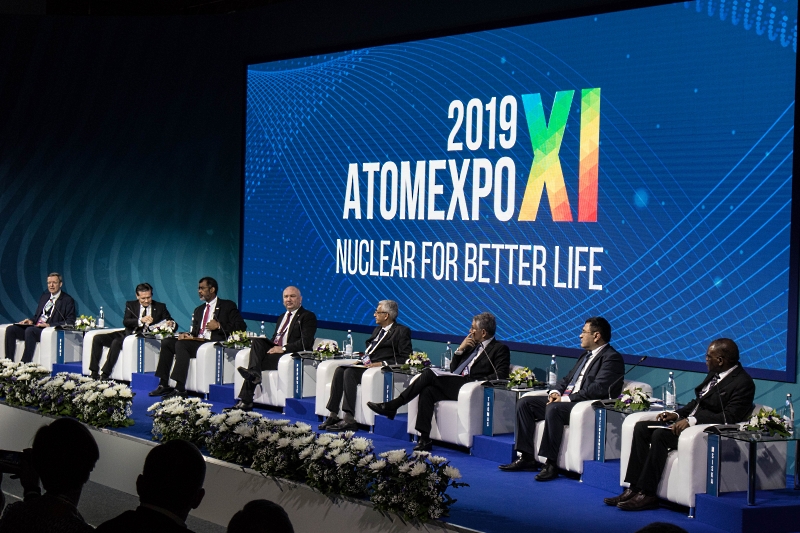
The representative of India spoke about successes - ten new PWR reactors and two light-water ones will be built in the country . Atomic technologies are used from desalination of water and agriculture to proton therapy against cancer.
The speaker from Uzbekistan explained why the country, having large gas reserves, is going to build nuclear power plants. Nuclear energy is economically viable, no matter how much gas, it will end, and a modern nuclear power unit can be operated for up to a hundred years. In addition, high technology of nuclear energy improves the scientific potential of the country and the development of society.
The European speaker said that the EU has the goal of abandoning hydrocarbons by 2050. And, since no technology survives on its own, the economic coexistence of different types of green energy, both solar, wind, and nuclear, is necessary.
The representative of Zambia spoke about the floods of 2015, which affected hydroelectric power plants. The country recognized the need for energy diversification and developed a plan for building a nuclear power plant. The result will not be fast, within 10-15 years, but now 50 students are studying at Russian universities, who will become heralds of progress.
The Minister of Innovation and Technological Development of Serbia recalled that the country had a long tradition of nuclear technology, broken after the collapse of the USSR. Now Serbia wants to develop high technologies and cooperate not only with Rosatom, but also with Roskosmos.
During the discussion, they raised the issue of Russian nuclear cities, which not only live better than their regions, but participate in state programs and take on more of the country's global agenda. Even the issue of gender equality was mentioned - it literally struck the eye with a gender imbalance between speakers and viewers.
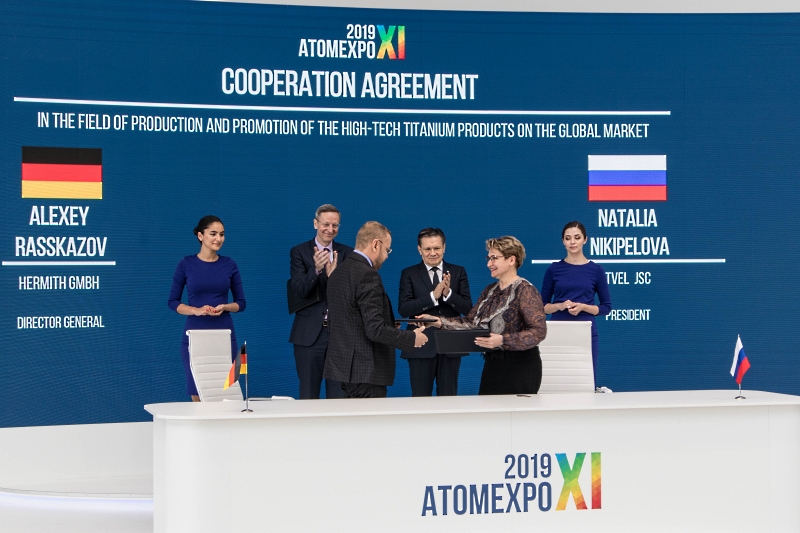
During the day, ceremonial signing of agreements took place. In total, they were concluded by more than forty.
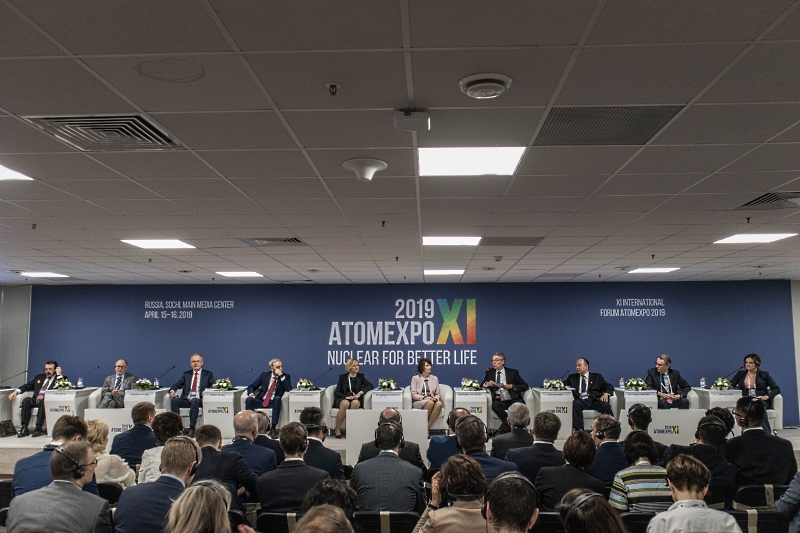
Parallel to the work of the exposition were round tables. As an IT specialist, I looked at the discussion on digitalization. A pleasant technocratic atmosphere reigned in the hall. New technologies are not only new opportunities, but also new challenges, so speakers recalled the recent disasters of the Boeing 737 MAX and the fact that now the problem may appear unexpectedly after updating the software version. In general, the nuclear industry is inevitably conservative due to safety requirements, but the complexity of the tasks and the high level of quality of work are its advantages in the market. Although, of course, as elsewhere, there are also difficulties: the IAEA expert, Dr. Pekka Tapani Pii complained that despite all the digital technologies, we are now unable to do what our predecessors could do - fit into deadlines and budgets.
A big surprise was waiting for me on the second day at the round table “Atomic technologies as a driver of scientific and technological progress”. Many of you have heard about tokamaks — experimental facilities and potential candidates for fusion reactors in which plasma is held in a torus-shaped (donut) chamber. There are alternative concepts where the trap camera is open. In order for the plasma to remain trapped, some way of holding it is needed. And one of the options is to create a swirling magnetic field, which, like a screw of a meat grinder, will “drive” the plasma back. But, twisting the "meat grinder" of the magnetic field in the opposite direction, you can get an electro-jet space engine!
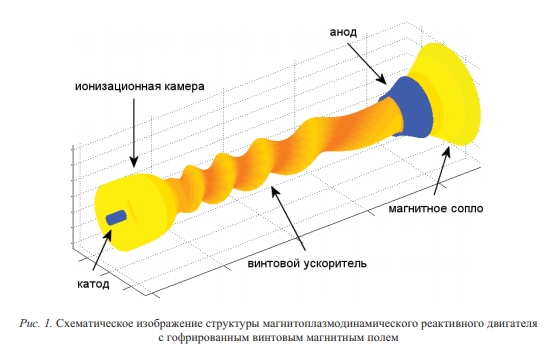
A source
At the same time, curious properties are found in the engine. The main plus is that it is omnivorous and can work on plasma from any fuel. The main disadvantage is that it is irrational to make it small and compact. Recently, an idea came up in the news about converting space debris into fuel, but a chemical engine was proposed there, which creates its own problems. And the omnivorous engine with a helical magnetic field makes it an obvious candidate for a heavy orbital scavenger.
Work on open traps is carried out at the Institute of Nuclear Physics. G.I. Budker, an experimental RESIN facility has already been created . And at Atomexpo, this side option of using open plasma traps was told by Aleksey Beklemishev, a senior researcher at the INP.

Speaker Alexei Beklemishev (center)
And I would like to finish the first part with a story about the presentation of the ATOMEXPO AWARDS Prize created in 2018. The award longlist included 52 projects from 25 countries that competed in five categories.

Winners and nominees, a memory photo
I express gratitude for the invitation to the press service of Rosatom and personally to Oleg Kondranenkov.
To be continued.

The forum was held in the Main Media Center. Large spaces, which in an empty form resemble a mixture of the airport and the pool, were transformed into something much more green and comfortable, but at the same time filled with high technology. Maybe that is what the future looks like.

Grand opening of the forum. To the left is Alexei Likhachev, Director General of Rosatom State Corporation, Agneta Rising, Director General of the World Nuclear Association, in yellow, the company is made up of senior officials of the IAEA, the European Commission and the OECD Nuclear Energy Agency.

The forum has registered more than 4000 people from 74 countries and more than 290 representatives of Russian and foreign media, the opening recorded dozens of various gadgets from action cameras and smartphones to professional devices.

After the grand opening and bypass of the exhibition, a plenary session began. It was opened by Sergei Kiriyenko, who led Rosatom from 2005 to 2016, who read out a welcome speech by Vladimir Putin and congratulated himself on his own.
The general theme of the forum was called “Atomic Technologies for a Better Life,” therefore they spoke a lot about the environment and about the sustainable development goals set by the UN . Do you know, for example, that due to atomic energy, 2 million tons of carbon dioxide were not released into the atmosphere? Despite the success of renewable energy, it will not be possible to achieve the UN climate goals without an atom. It is atomic energy that can provide clean water, quality medicine and light so that children can study on a dark evening and go to school instead of chopping wood.
The plenary meeting was attended by representatives of several countries, including Uzbekistan, Serbia and Zambia, I wrote down theses of speeches, fortunately, they turned out to be quite curious (or you canwatch the broadcast , starts at 23 minutes).

The representative of India spoke about successes - ten new PWR reactors and two light-water ones will be built in the country . Atomic technologies are used from desalination of water and agriculture to proton therapy against cancer.
The speaker from Uzbekistan explained why the country, having large gas reserves, is going to build nuclear power plants. Nuclear energy is economically viable, no matter how much gas, it will end, and a modern nuclear power unit can be operated for up to a hundred years. In addition, high technology of nuclear energy improves the scientific potential of the country and the development of society.
The European speaker said that the EU has the goal of abandoning hydrocarbons by 2050. And, since no technology survives on its own, the economic coexistence of different types of green energy, both solar, wind, and nuclear, is necessary.
The representative of Zambia spoke about the floods of 2015, which affected hydroelectric power plants. The country recognized the need for energy diversification and developed a plan for building a nuclear power plant. The result will not be fast, within 10-15 years, but now 50 students are studying at Russian universities, who will become heralds of progress.
The Minister of Innovation and Technological Development of Serbia recalled that the country had a long tradition of nuclear technology, broken after the collapse of the USSR. Now Serbia wants to develop high technologies and cooperate not only with Rosatom, but also with Roskosmos.
During the discussion, they raised the issue of Russian nuclear cities, which not only live better than their regions, but participate in state programs and take on more of the country's global agenda. Even the issue of gender equality was mentioned - it literally struck the eye with a gender imbalance between speakers and viewers.

During the day, ceremonial signing of agreements took place. In total, they were concluded by more than forty.

Parallel to the work of the exposition were round tables. As an IT specialist, I looked at the discussion on digitalization. A pleasant technocratic atmosphere reigned in the hall. New technologies are not only new opportunities, but also new challenges, so speakers recalled the recent disasters of the Boeing 737 MAX and the fact that now the problem may appear unexpectedly after updating the software version. In general, the nuclear industry is inevitably conservative due to safety requirements, but the complexity of the tasks and the high level of quality of work are its advantages in the market. Although, of course, as elsewhere, there are also difficulties: the IAEA expert, Dr. Pekka Tapani Pii complained that despite all the digital technologies, we are now unable to do what our predecessors could do - fit into deadlines and budgets.
A big surprise was waiting for me on the second day at the round table “Atomic technologies as a driver of scientific and technological progress”. Many of you have heard about tokamaks — experimental facilities and potential candidates for fusion reactors in which plasma is held in a torus-shaped (donut) chamber. There are alternative concepts where the trap camera is open. In order for the plasma to remain trapped, some way of holding it is needed. And one of the options is to create a swirling magnetic field, which, like a screw of a meat grinder, will “drive” the plasma back. But, twisting the "meat grinder" of the magnetic field in the opposite direction, you can get an electro-jet space engine!

A source
At the same time, curious properties are found in the engine. The main plus is that it is omnivorous and can work on plasma from any fuel. The main disadvantage is that it is irrational to make it small and compact. Recently, an idea came up in the news about converting space debris into fuel, but a chemical engine was proposed there, which creates its own problems. And the omnivorous engine with a helical magnetic field makes it an obvious candidate for a heavy orbital scavenger.
Work on open traps is carried out at the Institute of Nuclear Physics. G.I. Budker, an experimental RESIN facility has already been created . And at Atomexpo, this side option of using open plasma traps was told by Aleksey Beklemishev, a senior researcher at the INP.

Speaker Alexei Beklemishev (center)
And I would like to finish the first part with a story about the presentation of the ATOMEXPO AWARDS Prize created in 2018. The award longlist included 52 projects from 25 countries that competed in five categories.
- The Brazilian project for a multi-purpose gamma irradiator, which is used for radio sterilization, as well as disinfection and disinsection of cultural and art objects with a capacity of 20,000 artifacts per year, won in the nomination “Atomic Technologies for Improving the Quality of Life” .
- The prize for the best PR was received by the Creative Energy project from the Hungarian Paks NPP, dedicated to the reuse of furniture and other items. 2312 ideas from young people should influence our attitude to garbage.
- The symbol of the award, a Prometheus figurine, was received by a representative of the Chinese Tianwan NPPin the nomination “Best start” for the construction of power units 3 and 4. And his performance, in my opinion, deserved a separate award. Unlike all the other winners who spoke English, the Chinese in Russian said something like this: “When we built the 1st and 2nd power units, things went badly, we did not meet the budget or on time. Having gained experience, we abandoned all the wrong paths and went the only right way. Joke. Of course, despite the experience, problems started to arise again. But we, along with our Russian partners, did not look for the guilty, but began to eliminate these problems as much as possible. And in the end, we were able to successfully implement the project. ” It may look paler in print, but the live performance was really impressive.
- The Japanese company Marubeni Utility Services Ltd won the nomination “Innovations for the Future” with a project for the processing of nuclear waste.
- And in the last, fifth, nomination “Development of human capital”, the winner was the IAEA School of Management in the Field of Nuclear Energy .

Winners and nominees, a memory photo
I express gratitude for the invitation to the press service of Rosatom and personally to Oleg Kondranenkov.
To be continued.
